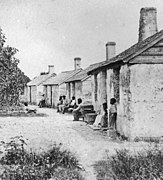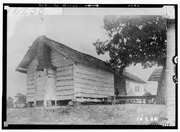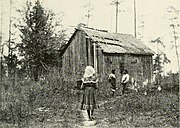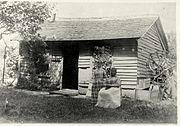For the quarters where enslaved people were held before sale at auction, see slave pen. For specific buildings, see List of slave cabins and quarters § United States.
 Sotterley Slave Cabin, Sotterly Plantation, Hollywood, St. Mary's County, Maryland, photographed c. 1933
Sotterley Slave Cabin, Sotterly Plantation, Hollywood, St. Mary's County, Maryland, photographed c. 1933 Sotterley Slave Cabin, built sometime between 1830 and 1850 in the Tidewater region, photographed 2011
Sotterley Slave Cabin, built sometime between 1830 and 1850 in the Tidewater region, photographed 2011
Slave quarters in the United States, sometimes called slave cabins, were a form of residential vernacular architecture constructed during the era of slavery in the United States. These outbuildings were the homes of the enslaved people attached to an American plantation, farm, or city property. Some former slave quarters were continuously occupied and used as personal residences until as late as the 1960s.
Rural slave quarters
Main articles: Plantation house and Plantation complexes in the Southern United StatesContext
Plantation slavery had regional variations dependent on which cash crop was grown, most commonly cotton, hemp, indigo, rice, sugar, or tobacco. Sugar work was exceptionally dangerous—the sugar district of Louisiana was the only region of the United States that saw consistent population declines, despite constant imports of new slaves. The cotton plantations used the grueling gang system. Some plantations used the task system, which permitted slightly more leisure time and thus development of domestic life amongst the enslaved. As a rule, personal freedom for slaves was restricted to what could be achieved in the slave quarters from sundown to sunup.


A traveler on the Mississippi in 1807 described the plantations in the vicinity of Point Coupee as having "Negro houses innumerable—being disposed almost contiguous to one another in a hurdle and adjacent to the manor house exhibit the view of small towns with their capitals." On some farms, slave houses were part of a larger, centrally located community group. For example, at Thomas Jefferson's Monticello, Mulberry Row was an area of the property where slave dwellings were built alongside a smokehouse, dairy, wash house, joinery, nailery/smithy, and a house where free stoneworkers lived during construction. After the stoneworkers left, the stoneworkers' house was used for textile production. Harriet Beecher Stowe quoted Rev. Westgate in A Key to Uncle Tom's Cabin (1853) about his impression of slave quarters, and he explained that construction materials depended on location and age of the site: "On old plantations the negro quarters are of frame and clapboards, seldom affording a comfortable shelter from wind or rain; their size varies from eight by ten, to ten by twelve feet, and six or eight feet high; sometimes there is a hole cut for a window, but I never saw a sash, or glass, in any. In the new country, and in the woods, the quarters are generally built of logs, of similar dimensions."
He had a number of negroes on his plantations, all of whom were lodged in hovels, as is the custom in this country.
— Francis Bailey, Journal of a tour in unsettled parts of North America in 1796 & 1797, published 1858
Field cabins
Field cabins were isolated and somewhat remote but offered agricultural workers close proximity to crop fields. Few field cabins survive as they were generally "left to rot" after the last residents departed.
Architecture and material culture
Rural slave quarters were usually one or two-room cabins occupied by a family unit. The individual rooms were called pens; houses were single-pen or double-pen. Some two-room cabins were duplexes hosting two families separated by a wall, each with their own entrance. Saddlebag plan houses had two units that were "separated by a central chimney". Dogtrot houses or open-passage houses had a breezeway between the two living spaces. Cabins with one room and a loft above were known as one up and one down.

On average, slave quarters were log cabins with dirt floors, clay chimneys, wood-shingle roofs, and one unglazed window. Windows lacking glass would have been covered with shutters or curtains. Slave houses built in the 19th century were more likely to have plank floors and be raised on piers. Typical 19th-century quarters were around 200 square feet in area. Some slave dwellings in the United States were wood-frame or masonry buildings; slave quarters at two sites in South Carolina were found to have African-styled, clay-walled, wattle-and-daub construction that was common in the Caribbean slave housing but extremely rare in North America. Brick was an uncommon building material, but some slave quarters were constructed from field stone; for example, local limestone was used in Maryland. Contemporary documentarians report that former slave houses often have low ceilings, little natural light, and feel "stuffy". The home of the slave owner on the plantation or farm was typically called the big house. Slave quarters were usually located near the big house but subsidiary in size and quality of construction, and subject to surveillance, inspection and regulation. In some cases the slave owner lived off-site but an overseer's house was built near the slave quarters.
Bedding was usually either straw on the floor or a straw-filled tick with a thin blanket. Bedframes were uncommon; where they existed, they were constructed with cord. Bureaus, tables, and chairs were uncommon. Possessions of cultural significance included homemade musical instruments such as drums and fiddles fashioned from dried gourds. Household goods in slave quarters were minimal but might have included work tools, iron cookware, pewter spoons, and locally made pottery (colonoware).

The slave quarters often developed independent systems for food and cloth production. Enslaved adults on a plantation were provided with specific food rations and clothing allotments but these were typically inadequate, so the slave quarters were a place where preparations were made for hunting, trapping, and fishing, where chickens were kept, and where kitchen gardens were tended. In some cases, with an eye to time efficiency and maximizing profit, there was a central kitchen that provided all meals. Despite the fact that marriages of enslaved people were generally illegal, slave quarters were the site of weddings and were the "cradle of the black family", as babies were born and families raised there.
Many slave quarters also hosted burial grounds for the dead. Burials in slave cemeteries were often poorly marked even when in active use (carved stone grave markers would have been impossibly expensive), and over the decades and centuries essentially disappeared into the landscape even when they were not actively erased. As one reporter wrote upon visiting the ruins of Prospect Hill in Mississippi: "No one yet knows where the slaves are buried, their wooden markers long since having crumbled into dust."
Urban slave quarters

Lacking the self-limiting isolation of the plantation, urban slave quarters nonetheless existed within a system designed to preclude insurrection and protect the race-caste system that underpinned the municipal economy. Urban slave quarters ranged from in quality from sturdy masonry barracks to rickety wooden shacks. Observers of urban compounds in Wilmington, North Carolina and Charleston, South Carolina noted that the slave quarters were typically at the back of the property, adjacent to a work yard, all surrounded by barrier walls. High walls were particularly common toward the rear property line and were likely intended to limit unsupervised entrance and egress by the enslaved. Urban slave quarters were often mixed-use blocks that combined residential space for the enslaved with laundries, privies, stables, and similar workspaces. In 19th century Charleston a typical arrangement would be a first floor with a laundry room and a kitchen, each with separate fires and chimneys, separated by a central stairway leading up to slave residences on the second floor. In other cases the upstairs living space was set above a carriage house or a shop. Many urban slave quarters were preserved after Emancipation because they served as still-useful servants' quarters, guest quarters, store rooms, etc.
The Encyclopedia of Louisville (2014) described slave quarters in the border-state city: "Generally, urban slaves' quarters were connected to their owners' property, usually in 'servant's rooms.' A typical newspaper ad from this period described a brick house for sale as having eleven rooms, two passages, a large kitchen, three servants' rooms, and a washhouse. Sometimes advertisements of this nature made it clear that the servants' rooms were in an outbuilding. In most cases, outbuildings were located behind the main house, on the alley. This is significant when coupled with the fact that most city lots, as evidenced by newspaper ads, were long and narrow. Thus, the white population was housed on the street side while their servants were relegated to the alley side of city lots."
"Free state" slave quarters
Slave quarters existed in northern states (in what would become the Union contra the southern Confederacy during the American Civil War), but they were less common and few have been preserved. Surviving examples of "free state" slave quarters exist at the Isaac Royall House in Medford, Massachusetts, and at the Lott House in Brooklyn. Ruins of dwellings may exist at Oak Ridge Park in New Jersey.
Scholarship and preservation
Former slave quarters are valuable resources for archaeologists studying daily life under slavery and expressions of cultural identity amongst the enslaved.
The still-extant Historical American Buildings Survey, originally established as a New Deal work-relief program, created an important photographic and documentary record of 485 slave houses. Current surveys of this historically significant building form include the Alabama Black Belt Slave Housing Survey; the Virginia Slave House Project; Joseph McGill's Sleeping With the Ancestors Project out of Charleston, South Carolina; and architect Jobie Hill's Slave Dwelling Database. Types of nails used, the thickness of any surviving glass, and the techniques used to saw lumber are used to date antebellum structures that may have been slave quarters.
There is significant variation in how historic sites interpret former slave quarters for visitors.
Additional images
Slave quarters of the United States-
 Building said to be "old slave quarters" Appleby Library, Augusta-Richmond County Public Library System
Building said to be "old slave quarters" Appleby Library, Augusta-Richmond County Public Library System
-
 Front view of "old slave house" at Strawberry Hill Plantation, Forkland, Alabama
Front view of "old slave house" at Strawberry Hill Plantation, Forkland, Alabama
-
 Beacon Tower and "negro cabin", Cockspur Island, Georgia, photographed 1863
Beacon Tower and "negro cabin", Cockspur Island, Georgia, photographed 1863
-
 Slave quarters at Tuckahoe Plantation, Virginia, photographed 1914
Slave quarters at Tuckahoe Plantation, Virginia, photographed 1914
-
 Slave quarters of the Owens-Thomas House, Savannah, Georgia
Slave quarters of the Owens-Thomas House, Savannah, Georgia
-
 Slave quarters made of tabby concrete, Kingsley Plantation, Fort George Island, Florida, photographed 1865
Slave quarters made of tabby concrete, Kingsley Plantation, Fort George Island, Florida, photographed 1865
-
Royall House slave quarters in Massachusetts, constructed 1732
-
 "Row of Negro Cabins", Destrehan, Louisiana, photographed 1938
"Row of Negro Cabins", Destrehan, Louisiana, photographed 1938
-
 Foundation of a ruined slave cabin, Bolling Island Plantation, Goochland, Virginia
Foundation of a ruined slave cabin, Bolling Island Plantation, Goochland, Virginia
-
 "Dogtrot house" slave quarters, Thornhill Plantation, Greene County, Alabama, photographed 1938
"Dogtrot house" slave quarters, Thornhill Plantation, Greene County, Alabama, photographed 1938
-
Cherie Quarters Cabins, Pointe Coupee Parish, Louisiana
-
 "Colored People's Schoolhouse", near Suwanee River, photographed 1904
"Colored People's Schoolhouse", near Suwanee River, photographed 1904
-
 Slave cabin at Boone Hall Plantation, Mount Pleasant, South Carolina
Slave cabin at Boone Hall Plantation, Mount Pleasant, South Carolina
-
 Slave cabin, location unknown
Slave cabin, location unknown
-
 Boxwood Plantation Slave Quarter, near Trinity, Alabama
Boxwood Plantation Slave Quarter, near Trinity, Alabama
-
 Slave quarters at Felix Vallé House State Historic Site, Ste. Genevieve, Missouri
Slave quarters at Felix Vallé House State Historic Site, Ste. Genevieve, Missouri
See also
- List of slave cabins and quarters § United States
- Slave pen
- List of slave owners
- Treatment of slaves in the United States
- Female slavery in the United States
- Invisible churches
- Praise house
- Pan toting
- Chesapeake pipes
- Face jugs § America
References
- "Archaeological Collections in Maryland, Sotterley Slave Cabin". apps.jefpat.maryland.gov. Retrieved 2023-02-18.
- ^ Dumas, Ashley A.; Mooney, Natalie; Moore, Valencia; Sly, Cory (January 2017). "Cabins as Far as the Eyes Can See" (PDF). The Alabama Review. 70 (1). University of West Alabama: 22–49. doi:10.1353/ala.2017.0001. ISSN 0002-4341. S2CID 164554921.
- ^ Young, Amy L.; Hudson, Blaine J. "Slave Life at Oxmoor" (PDF). Folsom Club Historical Quarterly.
- ^ Follett, Richard (October 2003). "Heat, Sex, and Sugar: Pregnancy and Childbearing in the Slave Quarters". Journal of Family History. 28 (4): 510–539. doi:10.1177/0363199003256928. ISSN 0363-1990. PMID 15295819. S2CID 41631256.
- ^ Schwartz, Marie Jenkins (2001). "Family Life in the Slave Quarters: Survival Strategies". OAH Magazine of History. 15 (4): 36–41. doi:10.1093/maghis/15.4.36. ISSN 0882-228X. JSTOR 25163462.
- Bedford, John R. (1919). "A TOUR IN 1807 DOWN THE CUMBERLAND, OHIO AND MISSISSIPPI RIVERS FROM NASHVILLE TO NEW ORLEANS. (Continued)". Tennessee Historical Magazine. 5 (2): 107–128. ISSN 2333-9012.
- Gardiner Hallock (2017). "Object Lesson: "Build the Negro houses near together": Thomas Jefferson and the Evolution of Mulberry Row's Vernacular Landscape". Buildings & Landscapes: Journal of the Vernacular Architecture Forum. 24 (2): 22. doi:10.5749/buildland.24.2.0022. S2CID 165206902.
- "A key to Uncle Tom's cabin; presenting the original facts and documents upon which the story is founded. Together with corroborative statements verifying ..." HathiTrust. p. 98. hdl:2027/uiug.30112003184378. Retrieved 2023-08-25.
- ^ Kennedy, Rachel; Macintire, William (1999). "AGRICULTURAL AND DOMESTIC OUTBUILDINGS IN CENTRAL AND WESTERN KENTUCKY, 1800-1865" (PDF). Kentucky Historic Preservation Office.
- ^ Young, Amy L. (1999). "Archaeological Investigations of Slave Housing at Saragossa Plantation, Natchez, Mississippi". Southeastern Archaeology. 18 (1): 57–68. ISSN 0734-578X. JSTOR 40713143.
- Owens, Sheldon Ben (2009). The Dogtrot House Type in Georgia: A History and Evolution (PDF) (Master's of Historic Preservation thesis). Athens, Georgia: University of Georgia.
- ^ Wallace, Edie (2007). "Reclaiming the Forgotten History and Cultural Landscapes of African-Americans in Rural Washington County, Maryland". Material Culture. 39 (1): 9–32. ISSN 0883-3680. JSTOR 29764375.
- ^ Singleton, Theresa A. (1995). "The Archaeology of Slavery in North America". Annual Review of Anthropology. 24: 119–140. doi:10.1146/annurev.an.24.100195.001003. ISSN 0084-6570. JSTOR 2155932.
- ^ Imbler, Sabrina (February 26, 2020). "Meet the Iowa Architect Documenting Every Slave House Still Standing - Atlas Obscura". Atlas Obscura. Retrieved 2023-02-18.
- ^ Vlach, John Michael (1987). "Afro-American Domestic Artifacts in Eighteenth-Century Virginia". Material Culture. 19 (1): 3–23. ISSN 0883-3680. JSTOR 29763792.
- Klingelhofer, Eric (1987). "Aspects of Early Afro-American Material Culture: Artifacts from the Slave Quarters at Garrison Plantation, Maryland". Historical Archaeology. 21 (2): 112–119. doi:10.1007/BF03373489. ISSN 0440-9213. JSTOR 25615636. S2CID 189846550.
- O'Neil, Patrick W. (2009). "Bosses and Broomsticks: Ritual and Authority in Antebellum Slave Weddings". The Journal of Southern History. 75 (1): 29–48. ISSN 0022-4642. JSTOR 27650401.
- Katz, Brigit (March 15, 2018). "A Slave Cemetery May Have Been Discovered at a Plantation Near Annapolis". Smithsonian Magazine. Retrieved 2023-02-18.
- Shapira, Ian (November 10, 2019). "Two Families — One Black, One White — Shared a Harrowing History. Then they Met". The Washington Post. ProQuest 2313107830.
This, the Beckers told them, is where the enslaved Kings are probably buried in unmarked graves. Oak and walnut trees dotted the area, which was smothered below with brush, poison ivy and wild rose hips. Growing up, Amanda told the Kings, she'd play by herself along the path and hold tea parties. When she and her sister got older, they'd venture into the bushy area and look for headstones. 'Nobody ever stumbled on a headstone?' Melissa asked. She tapped her neck with her finger over and over, while John rubbed his chin. The Beckers said they'd been told that their grandfather Vestus Wilcox, a lieutenant commander in the Navy, tossed the missing headstones over a hill somewhere. But they didn't know for sure. The Kings asked, is it possible to conduct a search? Amanda said she and her husband were exploring the possibility of purchasing radar equipment. 'It'll be detective work,' Frances said. 'We can find it.'
- Brown, Brittany (October 11, 2018). Ancestral Landscapes: a Study of Historical Black Cemeteries and Contemporary Practices of Commemoration Among African Americans in Duval County, Jacksonville, Fl (Ph.D. thesis). College of William and Mary. doi:10.21220/s2-hnxh-6968.
- "'This is surreal': descendants of slaves and slaveowners meet on US plantation | Mississippi | The Guardian". amp.theguardian.com. Retrieved 2023-09-08.
- ^ BISHIR, CATHERINE W. (2010). "Urban Slavery at Work: The Bellamy Mansion Compound, Wilmington, North Carolina". Buildings & Landscapes: Journal of the Vernacular Architecture Forum. 17 (2): 13–32. doi:10.1353/bdl.2010.a402207. ISSN 1936-0886. JSTOR 20839347. S2CID 161633485.
- ^ Herman, Bernard L. (1999). "Slave and Servant Housing in Charleston, 1770-1820". Historical Archaeology. 33 (3): 88–101. doi:10.1007/BF03373625. ISSN 0440-9213. JSTOR 25616727. S2CID 163361380.
- O'Brien, Mary Lawrence Bickett (2014) . "Slavery in Louisville". In Kleber, John E. (ed.). The Encyclopedia of Louisville. University Press of Kentucky. pp. 825–826. ISBN 978-0-8131-2100-0. LCCN 99053755. OCLC 900344482. Project MUSE book 37208.
- ^ Mooney, Barbara Burlison (March 2004). "Looking for History's Huts". Winterthur Portfolio. 39 (1): 43–70. doi:10.1086/431009. ISSN 0084-0416. S2CID 162729250.
- Fidurski, William. "Homestead Farm at Oak Ridge Application to National Register of Historic Places". nps.gov. Retrieved 2024-01-17.
- American Place: The Historic American Buildings Survey at Seventy-five Years (PDF). U.S. Department of the Interior Museum. 2008.
- Biser, Margaret (August 28, 2017). "I used to lead tours at a plantation. You won't believe the questions I got about slavery". www.vox.com. Retrieved 2023-02-18.
- "Plantation tours bypass the 'big house' to focus on the enslaved". Christian Science Monitor. ISSN 0882-7729. Retrieved 2023-02-18.
Further reading
- Eichstedt, Jennifer L.; Small, Stephen (2002). Representations of slavery : race and ideology in southern plantation museums. Washington. ISBN 1-58834-071-6. OCLC 48613596.
{{cite book}}: CS1 maint: location missing publisher (link) - Singleton, Theresa A. (1995). "The Archaeology of Slavery in North America". Annual Review of Anthropology. 24: 119–140. doi:10.1146/annurev.an.24.100195.001003. ISSN 0084-6570. JSTOR 2155932.
External links
- Encyclopedia Virginia: Housing for the Enslaved in Virginia
- Simkin, John (2014). "American History > Slavery > Slave Housing". Spartacus Educational.